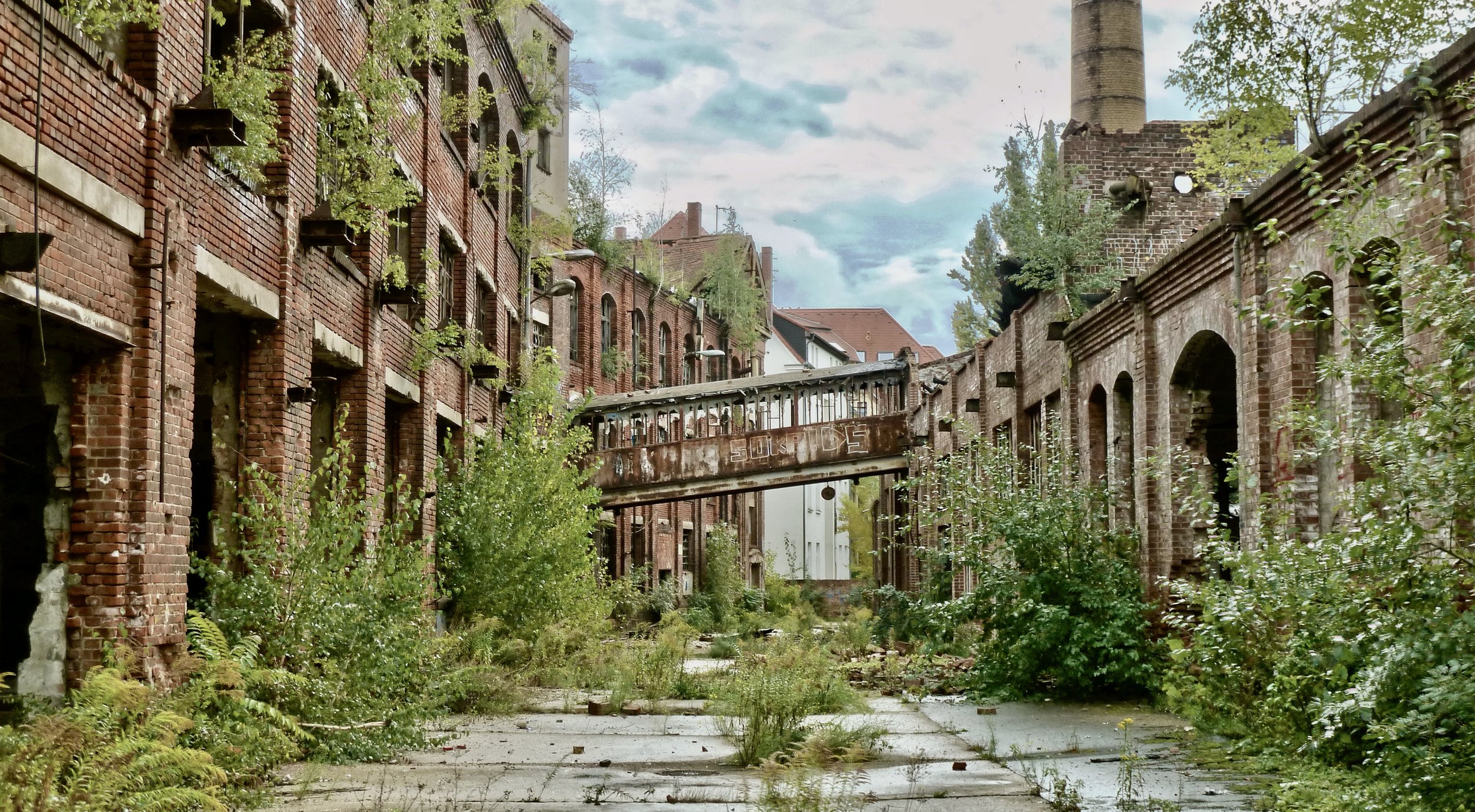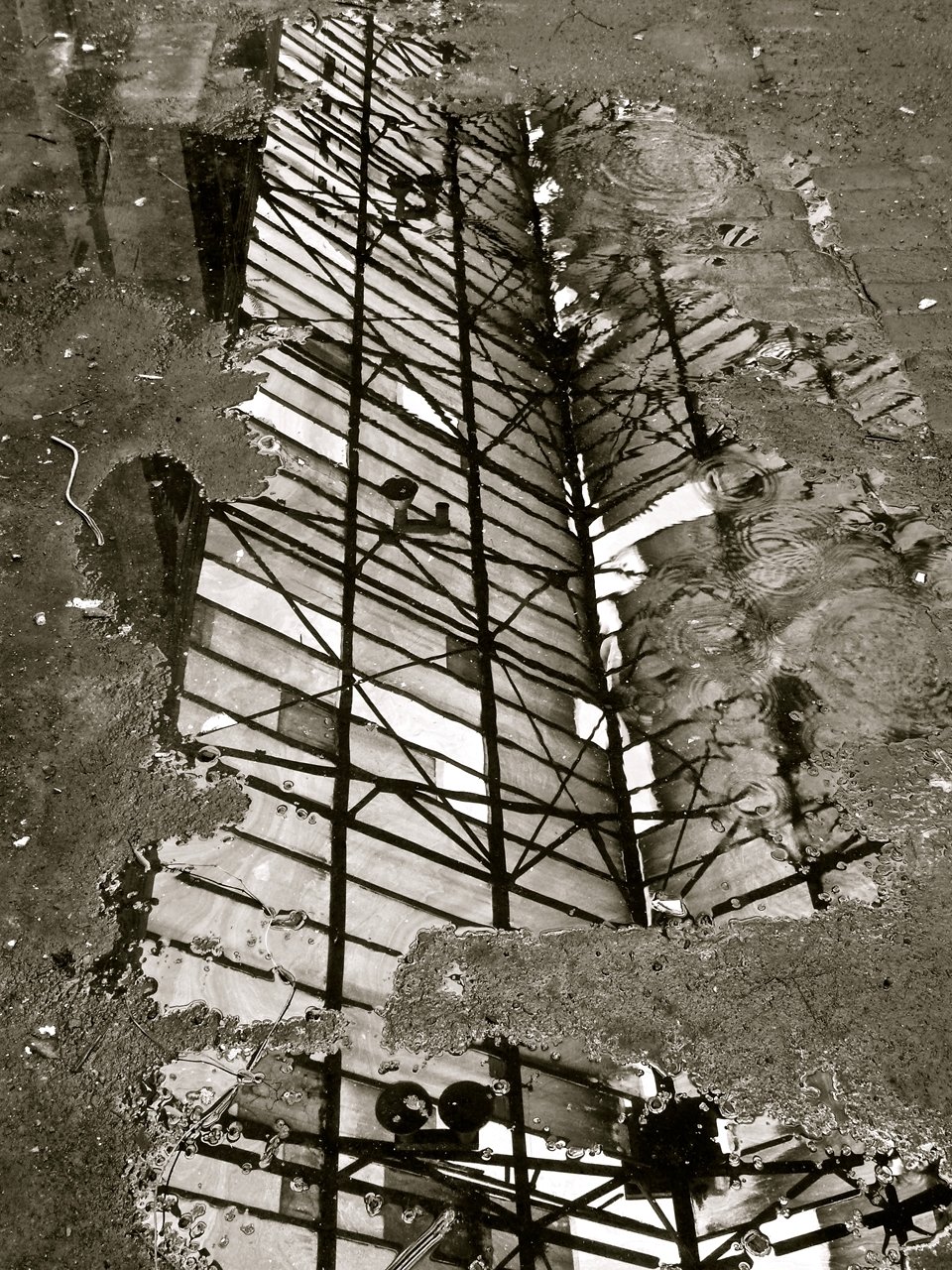Beauty in the Abandoned
Exploring the phenomenon of abandoned industrial buildings and its potential to influence new architecture.
The street reclaimed by nature at an old disused cable car factory in Leipzig, Germany.
Since the early days of my architectural training I have been fascinated by the phenomenon and experience of abandoned buildings and the beauty in their decay. In particular, I took an interest in abandoned industrial buildings and industrial sites, which I think appealed to me on a much deeper level owing to my passion for making, and an interest in machinery and industrial processes.
From a young age I was fascinated with taking apart machines to reveal their inner workings and in an attempt to understand (and to marvel at) their hidden complexity. As my experience of architecture developed in later life, this fascination shifted over to building technology and construction, and a deeper interest into how I could dream up and realise built spaces that impact us on a more meaningful and visceral level.
For me, architecture has never just been about building walls and making extra space, it means so much more. It is about people and materials, a journey through light and revelation, and a meaningful interaction between our eyes, hands mind and memory. Buildings start as just bricks and mortar, but as soon as we start to assemble them they begin to collect memories, to record events and become a bank of emotions and experience. A process has begun whereby it weaves an invisible network of interactions and narrative of meaning around a building, which to my mind is what gives a building a sense of soul and character. This is of course one of the reasons why I’m passionate about working with existing buildings, Listed buildings and with historic sites.
A new way of seeing and experiencing space.
These modern ruins appear to have no obvious function in daily life, clearly no utility or value to our current industry, but in their disuse and abandonment brings a calm silence that offers an entirely new way of experiencing a building and the fabric of its spaces.
As an architect I see great value in this experience which feels more emotionally poignant, where we feel more connected with a building and altogether more connected with nature. The latter in particular is of great importance to us as designers who strive to build more environmentally sensitive and sustainable buildings. At the heart of this endeavour must be an appreciation for the natural world and a greater awareness of how its effective utilisation and integration can be used to enhance our daily lives in buildings and the spaces we create around buildings.
This is a broad subject with a wealth of information online, largely compiled through advocates and participants of urban exploration and the Urbex community. These groups celebrate the adventure of experiencing these phenomenal sites and, importantly, document them before they are lost to decay. The Urbex community abide by a code of respect taking nothing but photos and leaving only footprints, but I would argue that there is much more to be taken away from these sites when we stop to consider what it is about them that makes for such a rich and engaging experience of place.
And so, onto the question I ask myself as I ponder memories of these old forgotten sites alongside my daily architectural routine; what can I take from this humbling experience of the abandoned building, and apply to creating new architecture for an altogether more meaningful and enriched experience of our built environment?
There is without doubt an element of the forbidden, the unknown and the nefarious, all of which add to the excitement and allure of the experience and cannot easily (or usefully) be translated into your everyday architecture. They do, however, also encompass a richer sense of exploration, intrigue and revelation. A stronger sense of mystery, personality and reward, all of which we could be looking to emulate in our new built environments.
These are the things we strive to achieve in our building designs when we think about:
How you arrive at and move though our buildings, and the journey they take you on.
How different views and spaces emerge and develop at different points in the building.
How natural light will pierce into and dance around the building interiors throughout the day.
How much the building decides to reveal to you about how it was built and the materials used to form its surfaces.
Architecture fuses science with art, and although there is obvious poetry to be read in these abandoned structures, the process of decay and gradual deconstruction can also offer useful insight into the technical design and construction of new buildings. Understanding how a building falls apart is a valuable lesson in how to put it together, better.
Equally useful is taking a few steps backward in this process before the building started to fall apart, to appreciate how the materials we choose will eventually start to wear with use, to weather down, and to patinate in texture and appearance during the years that follow construction. We take great pride in the selection of materials and specification of their finish to help shape the character of our architecture and interior designs. We favour natural materials for their greater tendency for imperfections and more forgiving nature when it comes to how they wear away and develop a personality. We choose finishes that will take the punishment of use but also allow the inherent and hidden beauties of the material to breathe and continue to evolve along with the memories we form around them.
(above) Inside the crane house of an abandoned cable car factory in Leipzig, Germany.
Undeniably there is an incredible amount of beauty in decay, and often the abandoned building is more readily compared to that of a landscape. This is certainly true in time as nature moves back in to reclaim the structure, and soon the lines between inside and outside, man-made and natural, become increasingly blurred. Our modern buildings by comparison are increasingly designed to reinforce the barrier between us and the outside world, and whilst conserving more energy and lowering the carbon footprint of our buildings is essential to protecting the natural environment, it can also leave us feeling more disconnected and unattached from the natural world.
What can we learn from these sites and is any of this transferable into creating new architecture that better engages our senses and connects us with the natural world?
In the abandoned factory there is greater harmony between building and landscape. There is a relationship here that evolves and shifts as entropy builds and the site becomes gradually reclaimed by the earth. In this state of being, the building shares a more intimate connection with nature, reacting to the seasons and weather for a phenomenon of ‘internal’ space quite unlike we’ve experienced in the every day hermetically sealed buildings we inhabit. These buildings occupy a small space in time between manmade building and untamed landscape, a transient state of being shrouded in a confusing sense of both sadness and joy. We want to cling onto our built heritage, but can’t begrudge this hard worked building its right to find peace, seen to be crumbling, deconstructing, now breathing and settled, but at rest.
When we think about designing a new building we cannot help but consider the garden spaces and landscape as an integral part of this composition. Just as we consider the interior design to be fundamental to great architecture, we consider the way a building connects with its surrounding landscape to be fundamental to the overall experience of architecture.
It is for this reason that we carefully consider how our buildings open up to views and how we go about defining the boundary between inside and outside. The simple detailing of a window (i.e. in its placement, size, height and fenestration) can make all the difference in terms of how well connected, exposed or sheltered a space can be made to feel. Strengthening our connection with nature doesn’t necessarily just mean allowing plants to climb the walls or bringing pots inside (although this can be great), but we can also look to create surprising and intimate moments inside a building where this boundary melts away and the outside garden feels as though part of the interior.
Whether its a planted light well used to illuminate the library, a well placed pocket garden accessed via the secret snug, or a glimpse view across the wind-blown grasses of a planted roof whilst descending the stairs, these all compose moments within a building where the architecture works to frame and reconnect us with nature.
Sometimes it’s just a case of thinking about space without a literal ceiling, about bringing external materials and features inside the building, and being more creative (and maybe more daring) with how we push space beyond the confines of the centrally heated shell.
The abandoned industrial building is now accelerating along its journey towards entropy, as its layers of paint peel back, its brick crumbles to dust and its foundations are silently torn apart by tree roots and freezing waters. It is as though the soul of the building is leaching out and draining back to the earth, and any remaining artefact of an ordered human occupation are now vividly juxtaposed with seemingly random blooms of nature.
Whilst we can design new buildings that attempt to emulate the precious qualities of the abandoned industrial building, another approach is simply to enjoy this phenomenon as an integral part of new space and use. The Zollverein Museum in Essen Germany and the Landschaftspark Duisburg-Nord (Landscape Park Duisburg North) in Duisburg Germany are amongst the best examples of this approach I have experienced. One is a former coal mine and coking plant (Essen), and the other a former ironworks (Duisburg-nord) and both sites have been reimagined and repurposed to allow visitors to enjoy the phenomenon of the abandoned industrial site on a truly landscape scale.
As with most things in architecture, my fascination with this subject is an ongoing journey of discovery and will continue to challenge my thinking around how to design for more extraordinary building experiences and space. Whilst not every project needs to be connected with a landscape or speak so directly to nature, there are other phenomenon at work in the abandoned building that teach us about creating play, wonder and surprise in the most unlikely of spaces.


















